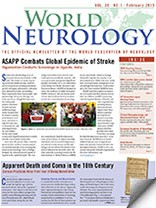
John D. England, MD
By John D. England, MD
The Journal of the Neurological Sciences (JNS) is a broad-based journal that publishes articles from a wide spectrum of disciplines, ranging from basic neuroscience to clinical cases. JNS strives to publish papers with novel, unique, and original observations. An indispensable step in identifying the best papers is the review of manuscripts by expert reviewers. The members of the Editorial Board and I depend heavily upon these individuals to help us make decisions about manuscripts.
Completing a good review of a scientific paper is difficult and time consuming. Several surveys indicate that many reviewers do not feel that they receive adequate recognition for this important work. In order to begin addressing this issue, Elsevier has instituted a “Reviewer Recognition” platform. Using this platform, reviewers can now access their personal review profile page, which shows the “Reviewer Status” and review history for JNS and 310 other journals that are published by Elsevier. Each reviewer is awarded a status, which is based upon the number of completed reviews. Currently, reviewers are awarded one of two statuses per journal: 1) recognized reviewer for completion of at least one review over a two-year period; or 2) outstanding reviewer for reviewers in the upper 10th percentile, based on the total number of completed reviews. Reviewers will also be able to collect other rewards such as certificates, badges or discounts. They may also share their profiles and status with others (e.g., colleagues, deans, chairs, followers or friends on social media).
The “Reviewer Recognition” platform is easy to access. After a review has been completed, each reviewer receives an email providing a direct link to the Elsevier review platform. We are hopeful that reviewers will find this initiative a positive and direct affirmation of their dedication to scholarly activity.
In our ongoing attempt to enhance accessibility of JNS articles to members of the World Federation of Neurology (WFN), we have selected two more “free-access” articles, which are profiled in this issue of World Neurology.
In this issue, we feature two paired articles on hypoglossal nerve stimulation and targeted activation of tongue muscles. Although the featured article is an experimental study in the rat, the results have important implications for the potential treatment of obstructive sleep apnea:
- In a series of elegant and detailed experiments, Paul Meadows and colleagues have demonstrated that subsets of hypoglossal nerve axons can be selectively and systematically stimulated in a manner that differentially activates specific lingual muscles and changes the size of the oropharyngeal airway. They achieved this by implanting an electrode array composed of eight independently controllable contacts applied to the hypoglossal nerves of rats. Their experiments showed that unilateral differential coordinated stimulation of the hypoglossal nerve selectively activates tongue muscles, and this muscle contraction can generate a coordinated and smooth opening of the oropharyngeal airway.
Meadows PM, Whitehead MC, Zaidi FN. Effects of targeted activation of tongue muscles on oropharyngeal patency in the rat. Journal of the Neurological Sciences 2014;346:178-193. - In an accompanying editorial, Alan Schwartz from the Johns Hopkins School of Medicine summarizes the study and comments on the importance of these experiments for developing better treatments for obstructive sleep apnea. Several implantable hypoglossal nerve stimulators have been studied as therapy for obstructive sleep apnea, but the results have been suboptimal. Dr. Schwartz states that “Additional work is still required to develop methods for identifying combinations of lingual muscles that act synergistically to maintain airway patency during sleep. These methods may necessitate steering current between specific electrodes as well as novel approaches for visualizing effects of stimulation on tongue shape, position, and stiffness.” Thus, the experiments of Meadows and colleagues have implications for the design and optimization of neurostimulation devices for the treatment of obstructive sleep apnea.
Schwartz AR. Hypoglossal nerve stimulation-Optimizing its therapeutic potential in obstructive sleep apnea. Journal of the Neurological Sciences 2014;346:1-3.
